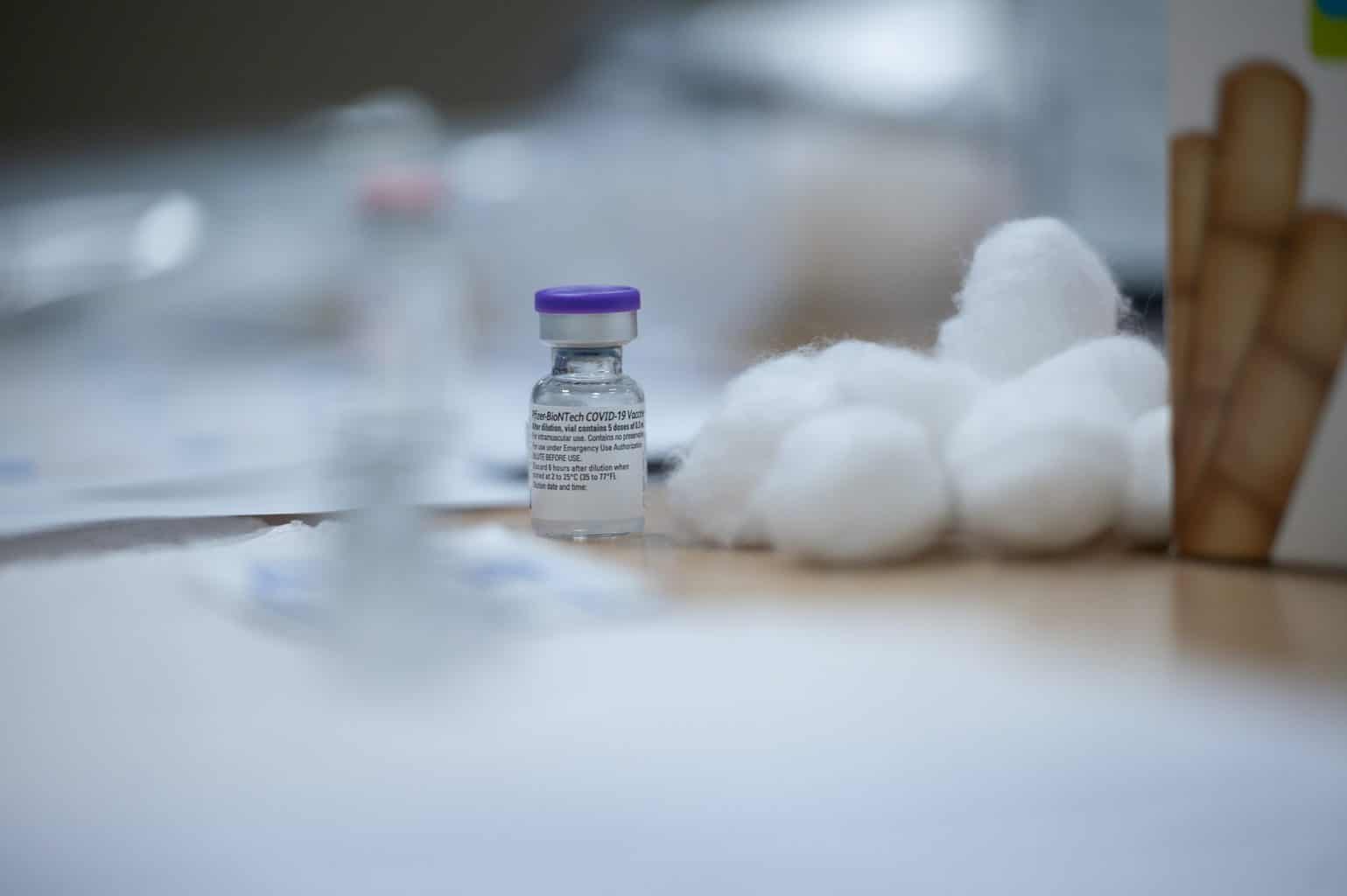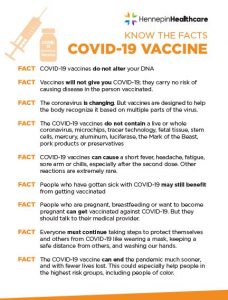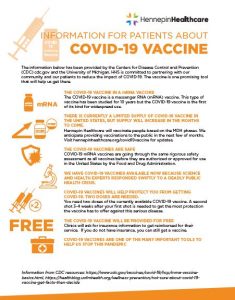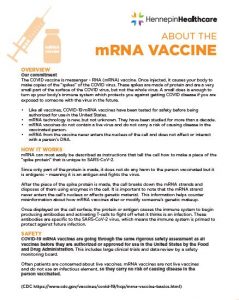
COVID-19 Vaccine
The COVID-19 vaccine is approved for everyone ages 6 months and older. Getting vaccinated is the best way to protect you and your loved ones.
(Updated October 19, 2023)
2023-2024 COVID-19 Vaccine Recommendations
On Sept. 12, the Centers for Disease Control and Prevention (CDC) announced updated COVID-19 vaccine recommendations. Everyone age 6 months and older needs to get a least one dose of the new 2023-2024 COVID-19 vaccine to be considered up to date. This updated vaccination is especially important for people at high risk of hospitalization and death.
Vaccination continues to be one of the best tools in our toolbox to fight COVID-19 and keep Minnesotans safe. Read more in MDH’s Statement on COVID-19 Vaccine Authorization.
We have the latest Pfizer COVID-19 vaccine boosters available in our clinics. You can schedule your vaccine appointment by calling 612-873-6963, or you can schedule via your MyChart account.
Summary of updated COVID-19 vaccine recommendations
- Children 6 months through 4 years of age should get at least one of the doses of the new 2023-2024 COVID-19 vaccine. The timing and number of doses depend on previous COVID-19 vaccines received, so talk to your child’s healthcare provider.
- People 5 years of age and older should receive one dose of the new 2023-2024 COVID-19 vaccine. If they have received any previous COVID-19 vaccine, the new 2023-2024 vaccine should be given at least 2 months after any previous dose.
- People who are immunocompromised should have three doses with at least one of the doses being the new 2023-2024 COVID-19 vaccine. They may also receive additional 2023-2024 COVID-19 vaccine doses based on their clinical situation.
Get the latest information about the COVID vaccine for children:
- COVID-19 Vaccine for Children and Teens - State of Minnesota
- Frequently asked questions about vaccines for 5–11-year-olds at our clinics
Call 612-873-6963 to make an appointment or schedule with MyChart.
About COVID-19 Vaccines
The COVID-19 vaccines currently being offered in the United States are the Pfizer-BioNTech, Moderna and J&J (Janssen) vaccines. Hennepin Healthcare is currently administering just the Pfizer vaccines.
Learn more about the vaccine:
Minnesota Department of Health (MDH)
Timing
All Minnesotans 6 months of age and older are currently eligible to receive the vaccine.
For more information regarding who should get vaccinated, visit the MDH vaccine plan web page.
Vaccine Safety
- If you received the Johnson & Johnson vaccine and develop a severe headache, abdominal pain, leg pain, or shortness of breath, please call your clinic or provider as soon as possible. Although very rare, the reported cases appear to occur within 3 weeks after vaccination.
- We expect most people who have already received the J&J (Janssen) vaccine will not have any complications from it.
We understand that there are concerns with the safety of COVID-19 vaccines. Hennepin Healthcare is confident in the science behind the vaccines and encourages you to learn more so that you are comfortable and confident in getting the vaccine.
The CDC offers helpful resources:
Equitable Distribution of Vaccines
Throughout the pandemic, we have been guided by a multidisciplinary group of thoughtful providers and other stakeholders at Hennepin Healthcare who consider ethical issues related to COVID, including our obligation to lead in addressing health equity by getting COVID-19 vaccine to the communities we serve. The limited and unpredictable initial supply of vaccines presented challenges as we faced high demand, systemic barriers, and an urgent need to “get shots in arms,” but we maintain a fierce commitment to move forward in a focused and equitable way.
To stand up the infrastructure quickly, and meet state goals for getting vaccines to patients, we started by using MyChart for the first wave as the most efficient and effective way to communicate to a large population of patients. Recognizing that MyChart likely disadvantaged certain target populations, we redoubled our efforts to engage with vulnerable populations by greatly expanding our list of tactics to reach out to patients who would be missed by traditional methods.
Reaching out to community for vaccination access
Our initial outreach targeted 15 Target zip codes in our catchment area defined by the Community Needs Index (CNI), which is a model that looks at 15 factors across five domains (income, culture—race/ethnicity/language, education, insurance, and housing). We identified the top 10 zip codes with highest rate of COVID-19 positive patients. Of these ten zip codes, six overlap with the CNI Target Zip Codes.
We reached out first to our patients from these areas by MyChart to give them access to scheduling the quickest, but recognized that these groups require more robust interventions since traditional technology-based solutions are not as effective. We put in place additional outreach activities with the following criteria as a guide: Unstable housing, using the Housing stability index score in EPIC; Limited English Proficiency (LEP) – self-identified in EPIC as “preferred language.” Target languages including Spanish and Somali, which represent 83% of all LEP patients; the clinical risk score—using our Hierarchical Condition Category (HCC) score and tiering, target groups in our high and extreme risk tiers.
Communication outreach activities have included:
- Emails and text messages in English, Spanish, and Somali
- Live and automated phone calls in English, Spanish, and Somali with the opportunity to connect to an operator to schedule an appointment or ask questions
- Social media
- Personal calls from providers to patient panels
- Personal calls from Somali- and Spanish-speaking providers and care team members
- Personal calls from interpreters to Somali and Spanish
- Personal calls from our Connection Center and/or Telehealth staff
- Personal USPS letter in various languages
Vaccination clinics in the community
To fulfill our shared commitment to vaccine equity, we also are collaborating with the state, county, and community partners to offer onsite vaccination clinics that meet our communities where they are. If you are interested in hosting or referring an organization for a community clinic, email [email protected]
Recent examples include:
- partnering with multiple churches and community centers serving local residents
- partnering with Hennepin County Community Health and Minneapolis Public Health to vaccinate residents and staff of assisted living facilities, educators, unaffiliated healthcare workers, emergency responders
- partnering with Hennepin County Community Health to vaccinate persons who are currently incarcerated
- partnering with Healthcare for the Homeless and MDH to vaccinate persons living in shelters
- partnering with Minneapolis Public Housing to vaccinate public housing residents
- partnering with St Anthony Village School System, UCare, and Healthfair 11 to independently stand up a community site to vaccinate unaffiliated healthcare workers and educators
We continue to develop new partnerships with community groups such as churches, community centers, and grassroots organizations to establish vaccine locations within the targeted areas.
As we identify barriers, including vaccine hesitancy in cultural communities, our providers are reaching out through trusted media channels to increase confidence in the safety and efficacy of the COVID-19 vaccine.




